|
Hudson
Motor Car Company in World War Two
Detroit, MI
1909-1954
Rest in Peace
This page updated on 1-30-2020. Hudson started production
in 1909. In 1954 it merged with Nash-Kelvinator to form
American Motors. The last Hudson, actually with a Nash
nameplate, was
produced in 1957. Hudson's Main Plant was located on East
Jefferson Avenue and Connors in Detroit, but no longer exists.
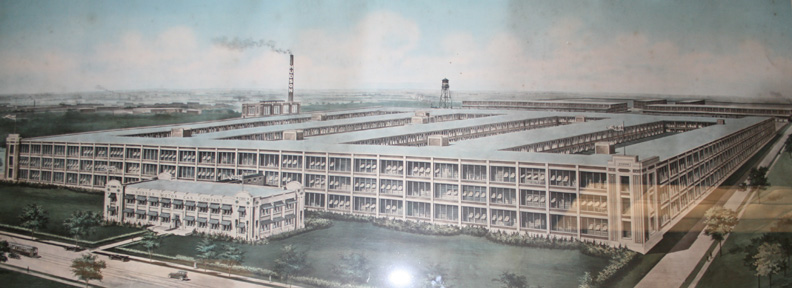
The Hudson Motor Car Company looking
Northwest. East Jefferson is the road in the foreground. This
is probably a pre WWII drawing.
Hudson Airplane Division, Main Plant, won the
Army-Navy "E"
Award twice during WWII.
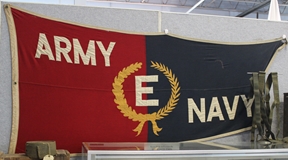
Hudson Motor Car Company World War Two Production Statistics:
The World War Two production is shown below in the table,
chronologically listed by Hudson start date. Note that Hudson primarily made airframe components for the
B-26, SB2C, P-63, P-38 and B-29. The atmosphere on the production
floor at Hudson must have been intense, starting in mid-944 with the
added B-29 rear fuselage and wing production. In just over a
year's time, it had to produce enough B-29 components for 531
aircraft. This was the most expensive project of the war, being
more expensive than the Manhattan project. (See the Martin B-29
production schedule at the bottom of this page.) Hudson accomplished
this while also making P-38 and SB2C wings. This was a production
miracle on the part of the Hudson Motor Car Company in World War Two!
|
Hudson Motor Car Company World War Two Production Numbers |
| Dates |
Product |
Number built |
Comments |
| 2-41 to ? |
P-47 ailerons |
? |
The first aviation contract. |
| 7-41 to 10-43 |
20mm Oerlikon anti-aircraft guns |
(33,201) |
The contract was
abruptly
canceled by the US Navy and the contract given to Westinghouse. |
| 9-41 to 1-45 |
Aluminum pistons for Wright aircraft engines |
(1,030,000) |
|
| 9-41 to 1-45 |
Rocker arm assemblies
Wright aircraft engines |
(1,460,000) |
|
| 3-42 to 3-44 |
B-26 Marauder rear
fuselage sections |
(1,891) |
Fuselages
were supplied to the Martin plant in Omaha, NB, which built 1,585
B-26 Marauder twin engine bombers before converting to B-29
production in May 1944. |
| 6-42 to
9-42 |
37mm armor piercing shells |
(310,551) |
|
| 12-42 to
9-44 |
License built Hall-Scott 250 hp Invader Marine Engines |
(4,000) |
|
| 1-43 to 8-45 |
SB2C Helldiver wing sets |
(4,250) |
|
| 3-44 to 8-45 |
P-63 King Cobra cabins |
(3,041) |
|
| 7-44 to 5-45 |
P-38 Lightning Wing sections |
791 sets |
Records
stop at the end of May but production is assumed to have continued
through August 1945 so the number of P-38 wing sets would have been
at least 1,000. |
| 7-44 to 8-45 |
B-29 rear fuselages |
(802) |
Martin
built 531 B-29 bombers at Omaha, NB which at first glance would
indicate that Hudson built more than enough rear fuselage sections
for aircraft. However, information presented below shows that
the company provided three different sections as part of the rear
fuselage, which is a total of 1,593 total fuselage components. This would have
been an aggressive production program for Hudson. As also
noted below the first B-29 came off the production line at Omaha in
May 1944.
Hudson would have had to started shipping components in April for them to be available for Martin's Start of Production. |
| 7-44 to 8-45 |
B-29 outboard wing sections |
? |
As shown
below this included the leading edge, wing section, aileron and wing
tip. Hudson supplied the Martin B-29 plant in Omaha, NB where the
first of 531 B-29s came off the assembly line in May1944.
Hudson would have had to produced 1,062 of each wing component. This, along with the B-29
fuselage production by Hudson would have stretched its production
capability to the utmost. |
My research has uncovered references to Hudson building the following
parts during WWII. However, I have not yet been able to
substantiate that Hudson actually built them during WWII. The
unsubstantiated parts are: Hercules DNX
diesel engine components, ammunition boxes, aircraft engine starter
parts, tank components and fighter drop tanks.
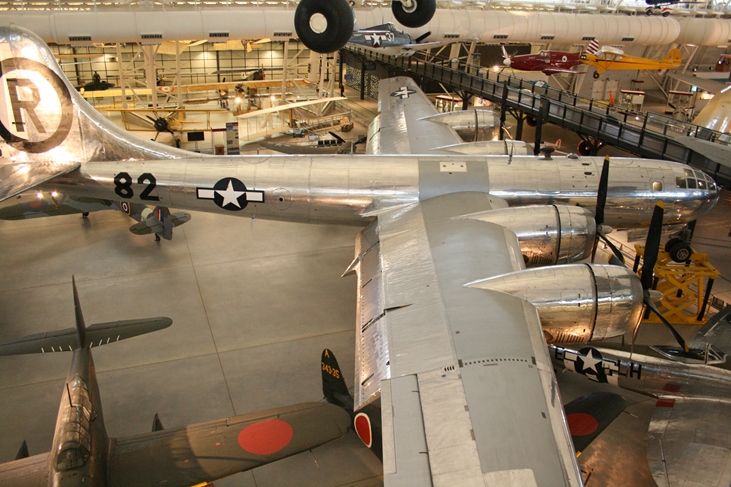
This is the B-29 "Enola Gay", now on display at the Steven F. Udvar-Hazy Center of the Smithsonian Air and Space Museum in Chantilly,
VA. It is famous for being the aircraft that dropped the first atomic
bomb on Hiroshima, Japan. Significantly, the rear
fuselage sections, wing tips, outer wing sections, outer wing leading
edges and ailerons were built in Detroit, MI by the Hudson Motor Car
Company. As shown below, Hudson was one of many auto companies and
their suppliers to contribute major components to the B-29s built at
Martin's Omaha B-29 plant. Martin Omaha built the B-29
"Silverplate" nuclear bombers, including the "Enola Gay" and
"Bockscar", the Superfortress that dropped the second atomic bomb on
Nagasaki, Japan. In
the photo above, Hudson built the two fuselage sections that extend from
behind the wing to the tail gun position, and the outboard
wing sections, and leading edge wing sections.
The wing tip is not visible in this photo. Author's
photo added 11-12-2015.
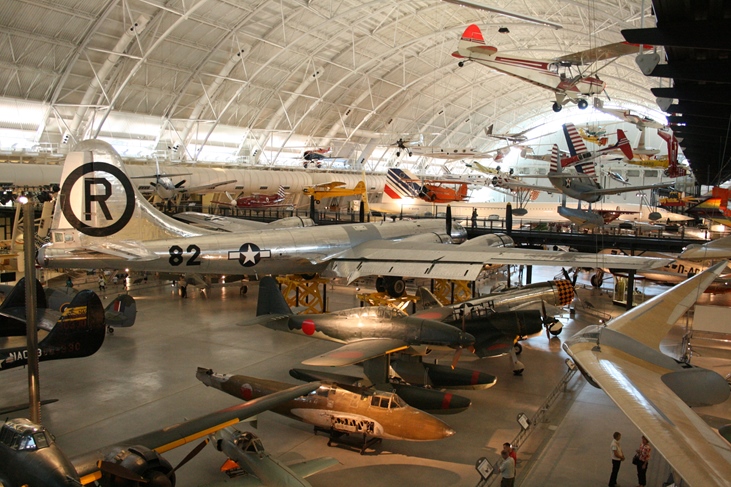
This photo gives a view of the
Hudson built rear fuselage sections, the outer wing section, ailerons,
and the wing tip on the B-29 "Enola Gay". Author's
photo added 11-12-2015.
Prior to making the B-29 rear fuselage
section, Hudson had been supplying the same component for the Martin
B-26 Marauder. When Martin converted to
the B-29, the company contracted the same suppliers previously used for
the Marauder. For Hudson, moving to the larger and more
complicated B-29 rear fuselage was no trivial task. Ultimately,
Hudson provided at least 802 rear fuselages for the 531 B-29s built in Omaha.
As there are no known production numbers for wings components available,
it has to be assumed that Hudson provided B-29 outer wing components on time and in
the needed quantities. While it is immaterial 75 years later, I always try and clean up the loose ends.
I can not do it in
this case. If new information becomes available during my
research, I will update the page.
In any event, Hudson was taxed to the limit
to provide all of these complicated B-29 components.
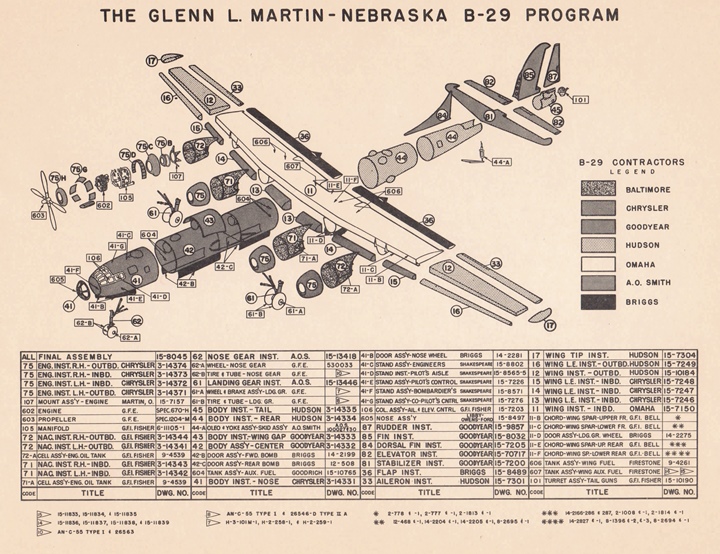
In this Martin supplier diagram Hudson is
shown as the supplier for components #12, #16, #17, #33 #44(2) and #45.

Hudson supplied these components as per the
Martin nomenclature.
#12 - Wing Inst-Outboard
#16 - Wing LE Inst - Outboard (Leading Edge)
#17 - Wing Tip Inst.
#33 - Aileron Inst.
#44 - Body Inst. - Rear (2 sections)
#45 - Body Inst. - Rear
With the Glenn
Martin Omaha, Nebraska B-29 Program diagram shown above, supplied by B-29
historian Chris Howlett of the UK, it is now evident that Hudson's
involvement as supplier for the Omaha, NB built Superfortress was significantly beyond what was previously known. It was a major supplier.
The following photos are in the order
from
the start of production.

Hudson's first military contract starting
February 1941 was for Republic Aircraft P-47 ailerons.
They can be seen being constructed in the Hudson plant.
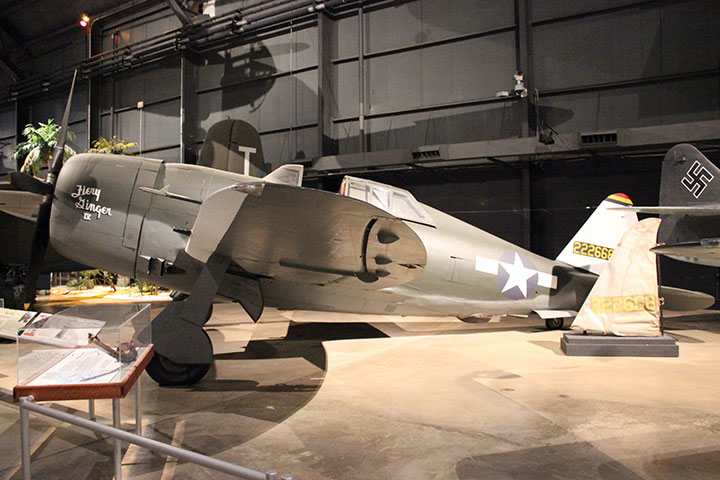
The wings on the Republic P-47 are
semi-elliptical, as can be seen in this photo. The ailerons,
located at the end of wings, have the same shape. Author's photo
from the National Museum of the US Air Force.
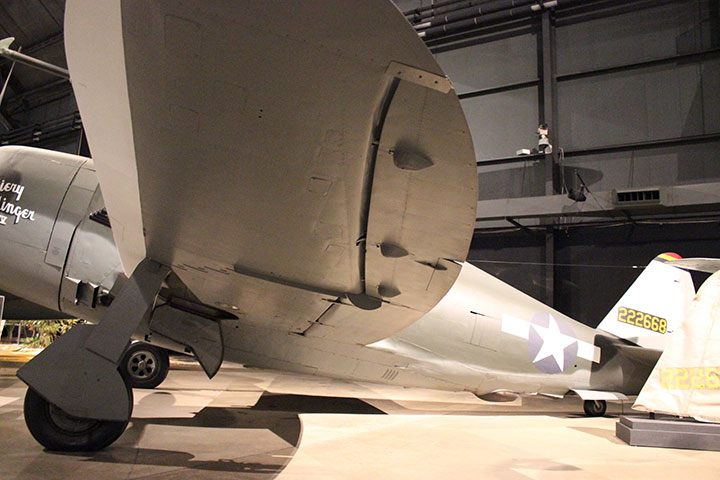
An unknown number of the P-47 ailerons were
produced by Hudson early in the war, or even before the US became
involved. Author's photo.
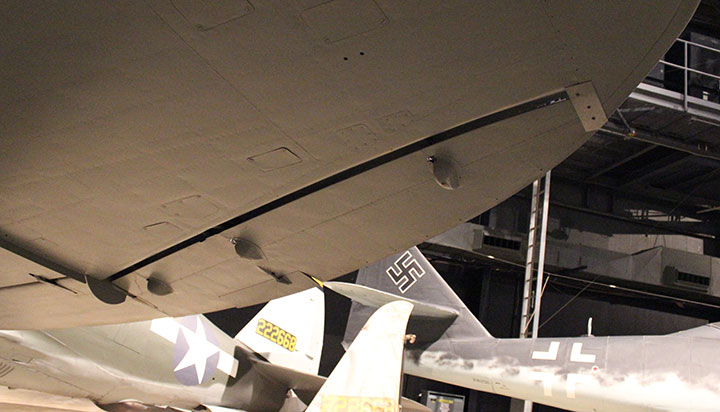
Author's photo.
During the Second World War Hudson also operated a
Government built Navy Ordnance Plant in Centerline (Warren), MI for the manufacture of 33,201
20mm Oerlikon anti-aircraft guns. This was a $20,000,000 plant
built in 1941 that began production July. Originally it was a
400,000 square foot facility contained in 113 acres. During
construction, expanded to one million square feet. At the same time the acreage expanded to
135 acres. The original contract was for 8,000 guns for
$14,038,500 or $14,548 per gun. Something went wrong somewhere
because even though in 1942 Hudson was the largest producer of 20mm Oerlikon
guns and hit a peak production of 2,330 units in September 1943, the US Navy terminated the contract the next month.
The business was awarded to Westinghouse. Because the Centerline
Plant and equipment in the plant belonged to the US Navy, most
likely all of the 4,000 people working there, including probably most
of the supervision were Hudson employees one month and Westinghouse
employees the next. Today, this facility is the GM Powertrain Transmission
Plant located on Mounds Road at Nine Mile Road.
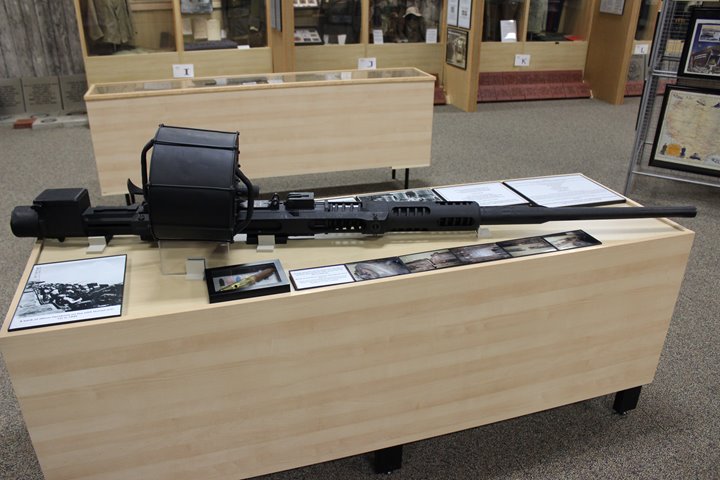
Here is one of the 33,201 20mm Oerlikon
anti-aircraft guns built at the Centerline, MI plant; first by Hudson,
and then by Westinghouse. Author's photo added 2-21-2017.
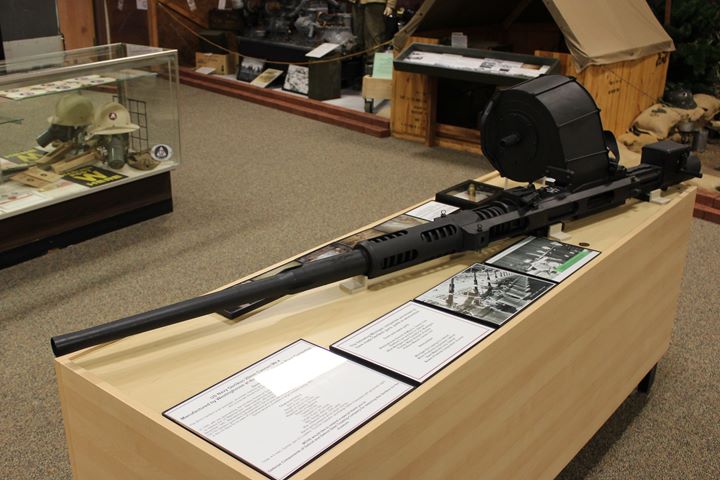
This is one of the great displays of items
built for defense by Michigan companies. It is located in The
Michigan Military Technical and History Society Museum in Eastpointe,
MI. Author's photo added 2-21-2017.
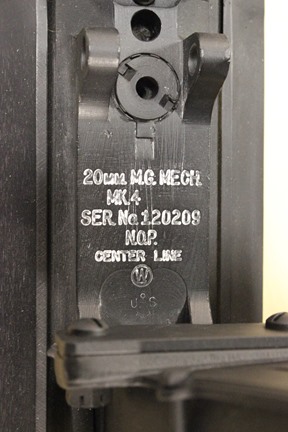
This is a Westinghouse built version, as it
has the "W" ID stamp on it. The Hudson versions were identical,
as they were produced by the same tooling, people, and plant. Only the top
management changed. Author's photo added 2-21-2017.
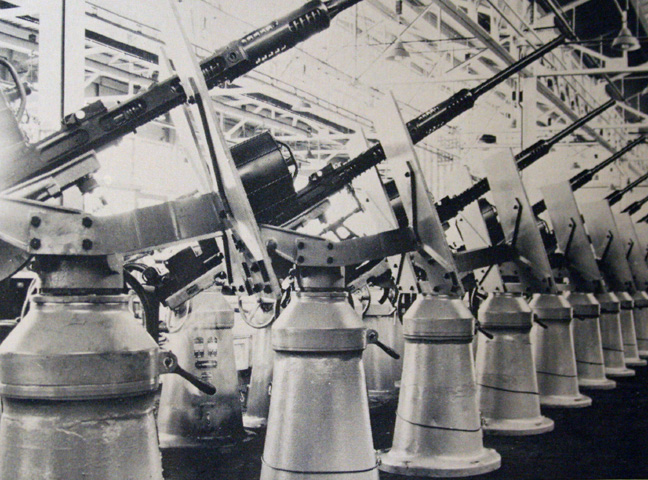
Some of the 33,201 20mm Oerlikon anti-aircraft
gums manufactured by Hudson at its Centerline, MI plant during WWII.
Pontiac also produced the same weapon for the Navy.
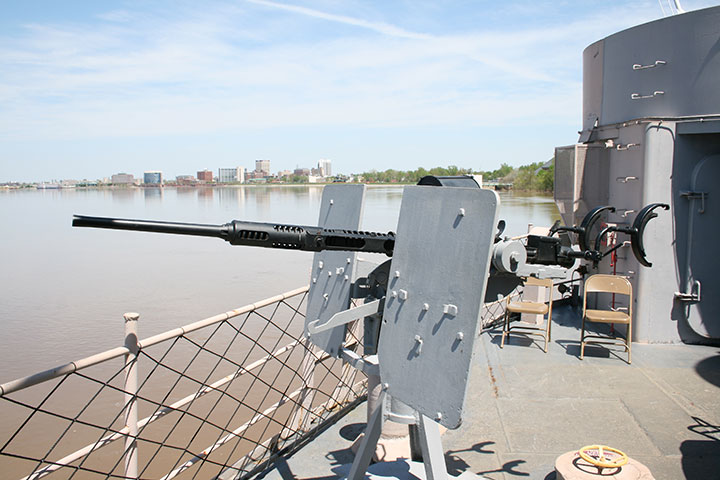
This 20mm cannon can be found on the LST-325
along the Ohio River in Evansville, IN.
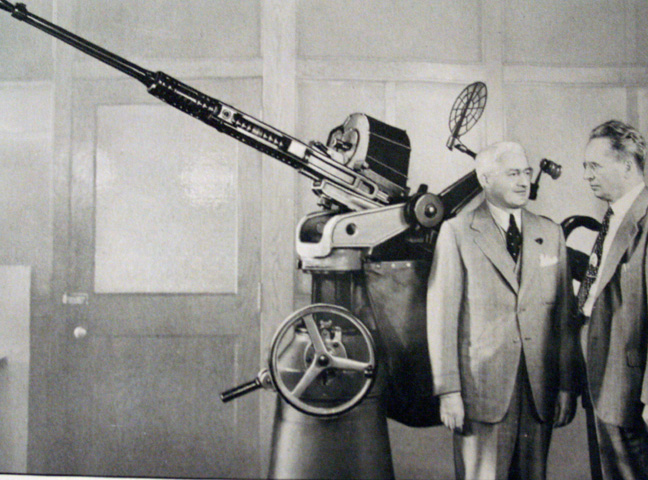
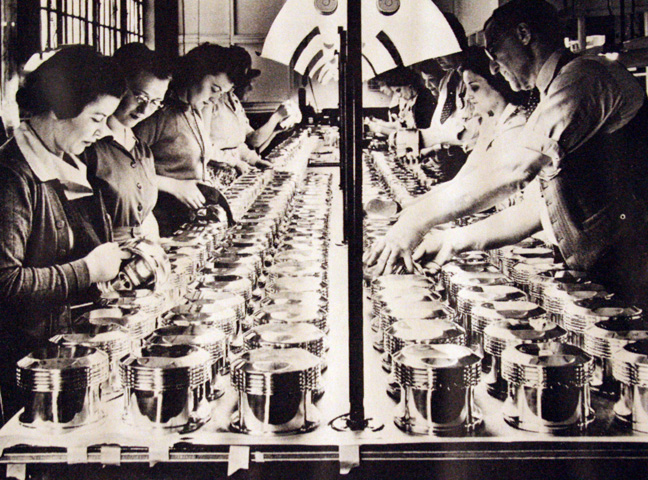
Hudson's third military contract was for aluminum pistons for Wright Cyclone
Aircraft Engines.
1,030,000 were produced at the Hudson East Jefferson plant between
September 1941 and the end of WWII.
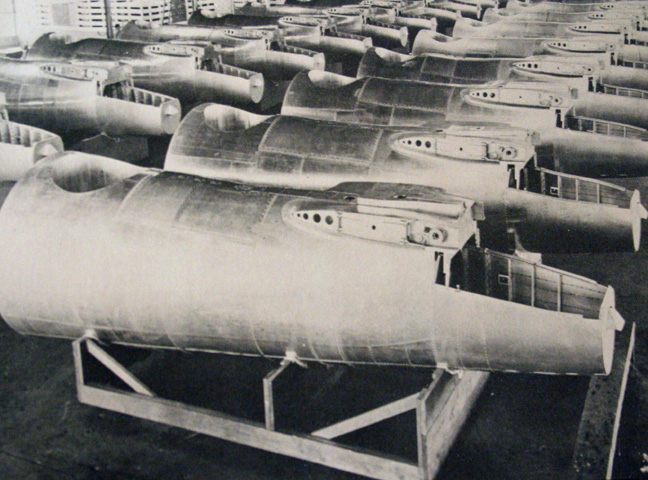
Rear fuselage sections for the Martin B-26
Marauder at the Hudson plant. The company produced 1,891 of the
airframe components during a two year period from March 1942 to March
1944.
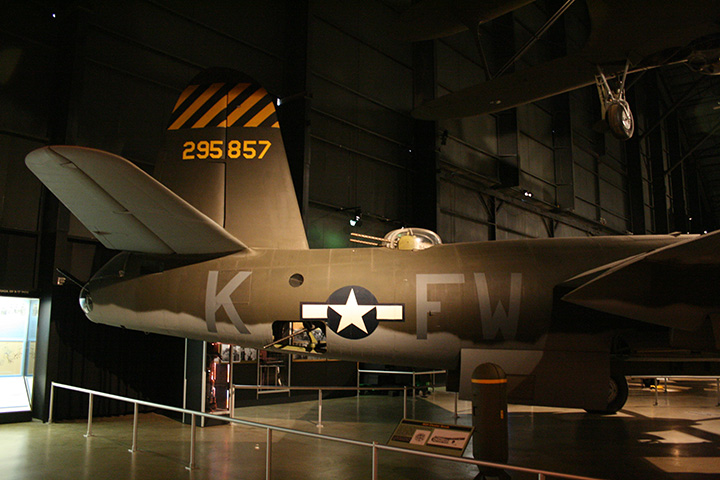
The rear fuselage of the B-26 at the Air
Force Museum. This was the section Hudson made for the Martin Omaha
plant. Author's Photo.
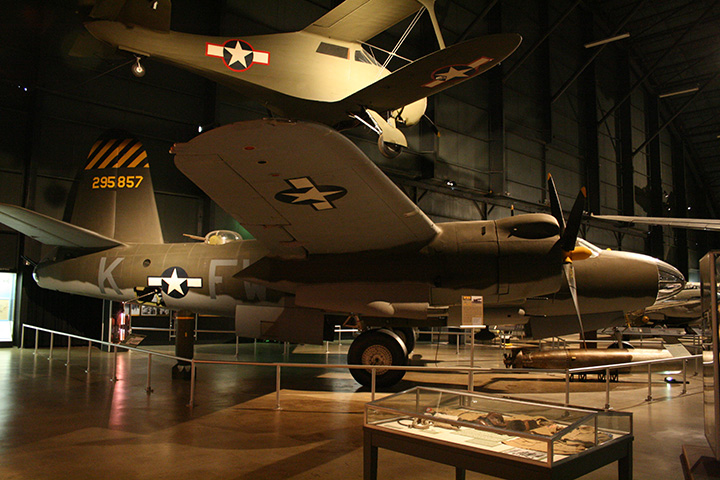
The Martin B-26 at the Museum is one of two currently on display in the United States.
Both of them are in Ohio, with the second B-26 on display at the MAPS
Museum in Canton, OH.
Author's Photo.
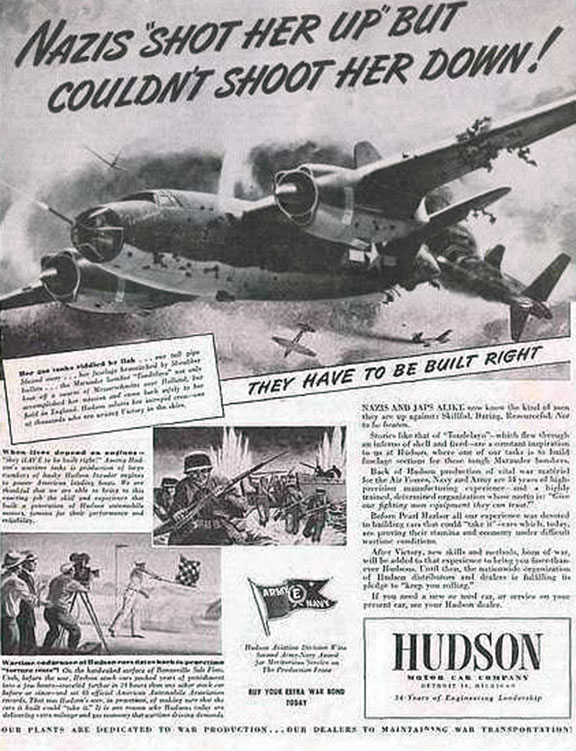
Hudson advertised its association with the
B-26 in this World War Two advertisement. Note that the ad is
displaying the Army-Navy "E" for Excellence Award.

The 250hp Invader marine gasoline powered
engine shown above was a license-built Hall-Scott Motor Car Company
design. The Invader was the last engine designed by Elbert John
Hall before he left Hall-Scott in the early 1930s. Hudson took the
liberty of putting its name on the engine in several places which it
wasn't supposed to do. In the literature that specifies the
applications on the small landing craft where the engine was used, it is
identified as a Hall-Scott engine, not a Hudson. However, most Invader engines used in landing craft during World War Two were
built by Hudson. Production
of the engine ran from December 1942 until September 1944 during which time
4,000 were built for the US Navy.
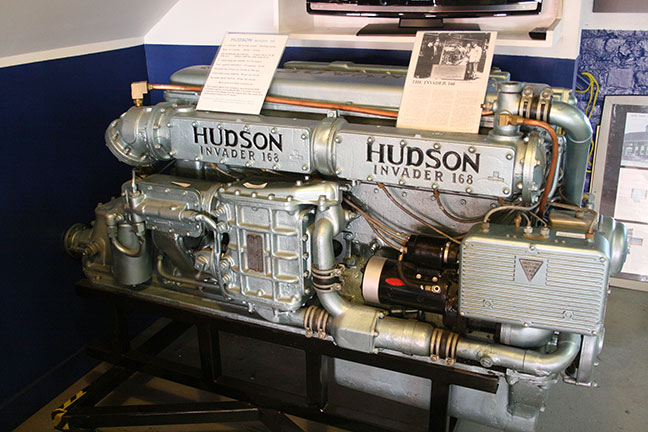
Hall-Scott had been building the Invader
engine for marine applications since 1931. Once the United States
entered the World War Two in December 1941, Hall-Scott did not have the
capacity to produce the Invader engine along with the other engines the
military was needing from the company. Therefore, it made a deal
with Hudson to produce the Invader engine. The Navy specified that
the Hudson-built version of the engine obtain 250 horsepower.
Hudson's version of the engine exceeded this requirement and tested out
at 263.7 hp. The Invader Engine above is at the Ypsilanti
Automotive Heritage Museum Ypsilanti, MI. Author's Photo.
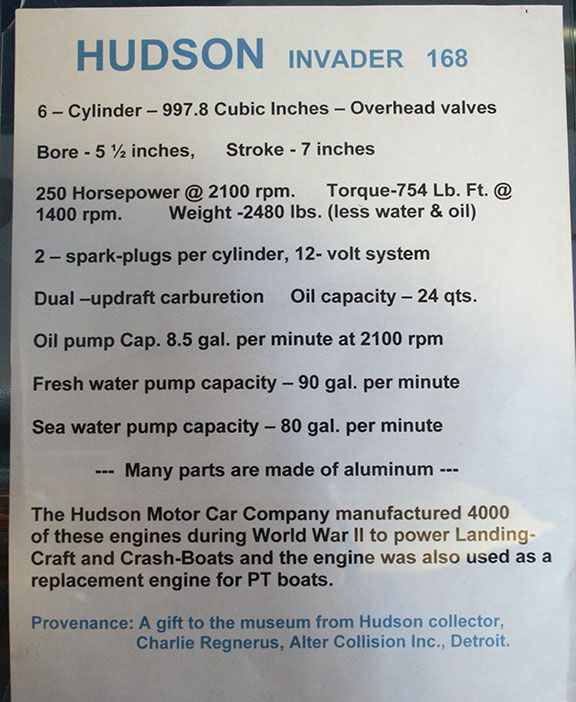
There were several differences between the original Hall-Scott Invader
and the Hudson version. The U.S. Navy required the Hudson version
to have a heat exchanger to better cool the engine, which for the Hudson
version fresh-water. Hall-Scott along with the rest of the marine
engine industry normally used salt-water cooling. In
order to manufacture the engine in its former auto assembly plant,
Hudson had to install over 6,000 fixture, quality control gauges, tools
and jigs that were shipped from the Hall-Scott plant in Berkeley, CA. It also converted 800 machine tools from its automobile
production to get tooled up between October 1942 and start of production
in December 1942.
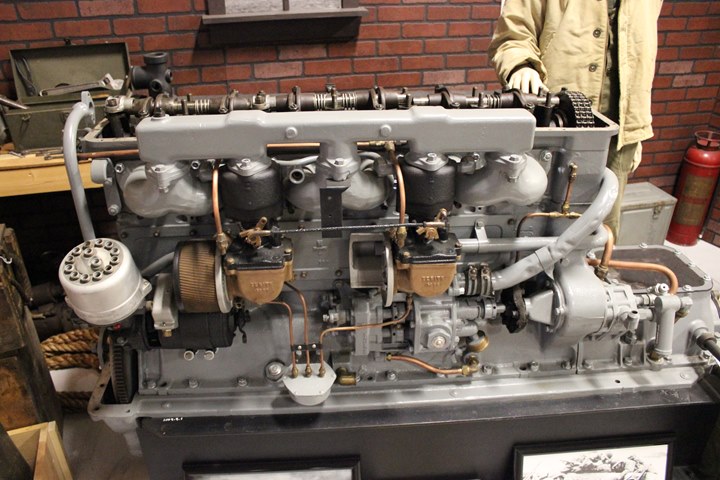
The Michigan Military Technical and History
Society Museum has a fine example of the Hudson Invader engine on
display. Author's photo added 2-21-2017.
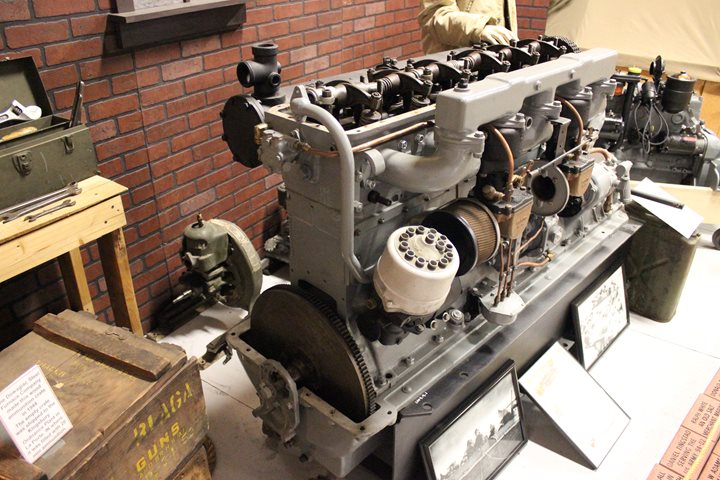
Author's photo added 2-21-2017.
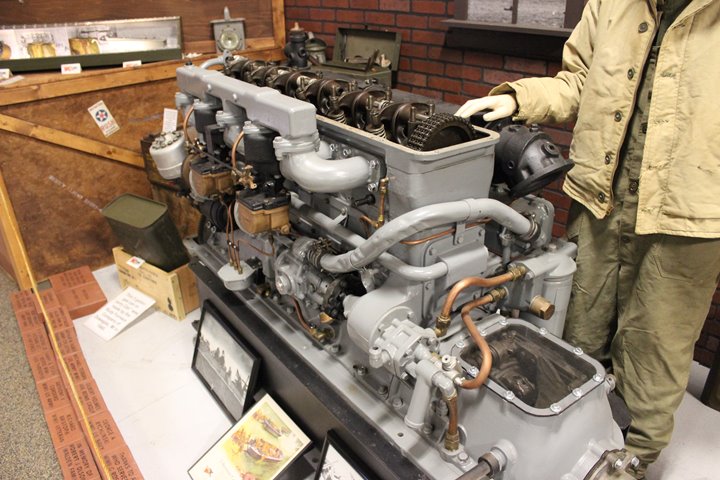
Author's photo added 2-21-2017.
Partial Listing of Hudson-built
Invader Engines
The type landing craft the Navy ship serial numbers match-up
to is unknown. These 36-foot wooden landing craft were
LCP(L), LCP(R), LCV and LCVP. |
| Hudson Invader Engine Serial
Numbers |
U.S. Navy Bureau Of Ships Serial
Numbers |
Lot Number |
| HU-40001 to HU-40500 |
A-14729 to A-15228 |
1 |
| HU-40501 to HU-42000 |
A-16278 to A-17777 |
2 |
| HU-42001 to HU-43000 |
A-28387 to A-29386 |
3 |
| HU-43001 to HU-44000? |
?? |
4? |
The four types are shown below.
LCP(L) (Landing
Craft, Personnel, Large):
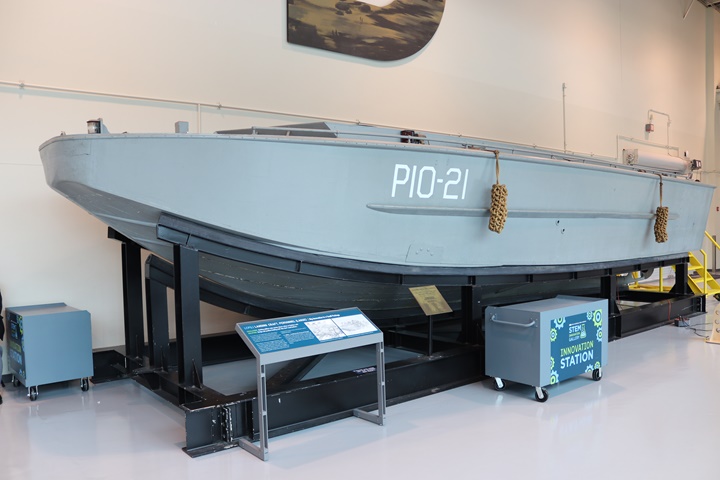
This 1944 Landing Craft, Personnel, Large (LCP(L))
was the first type of landing craft that Andrew Higgins designed.
This particular boat was built by Higgins Industries in New Orleans in
October 1944, and is currently on display at the National WWII Museum in New Orleans.
It has returned home for museum visitors to see. It is the
only one on display left in the world. Author's photo.
The engineering drawings below show the engine
placement in the LCP(L) and the plumbing for a Hall-Scott Invader fresh
water cooled engine. While the engineering drawings show the
engine as Hall-Scott, it was actually the Hudson-built Invaders that
were used in this landing craft. Hudson built the freshwater
cooled version of the Invader. The engineering drawings below were
drawn up when in late 1941 before Hudson became involved in the Invader
program.
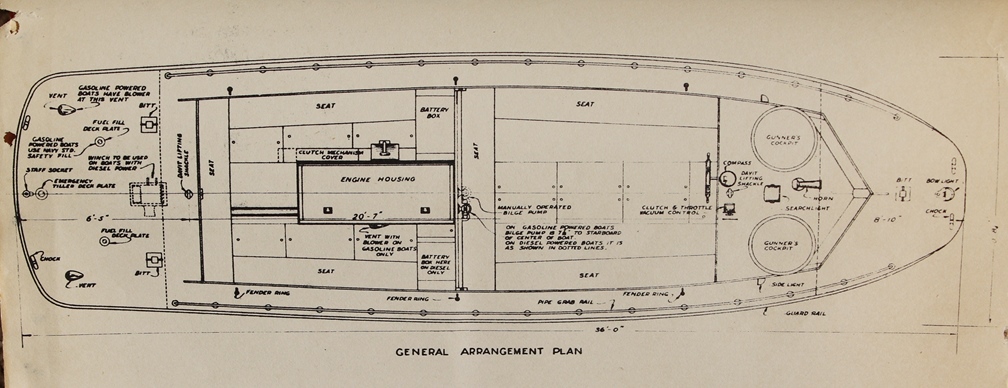
Engineering drawing added 1-30-2020.
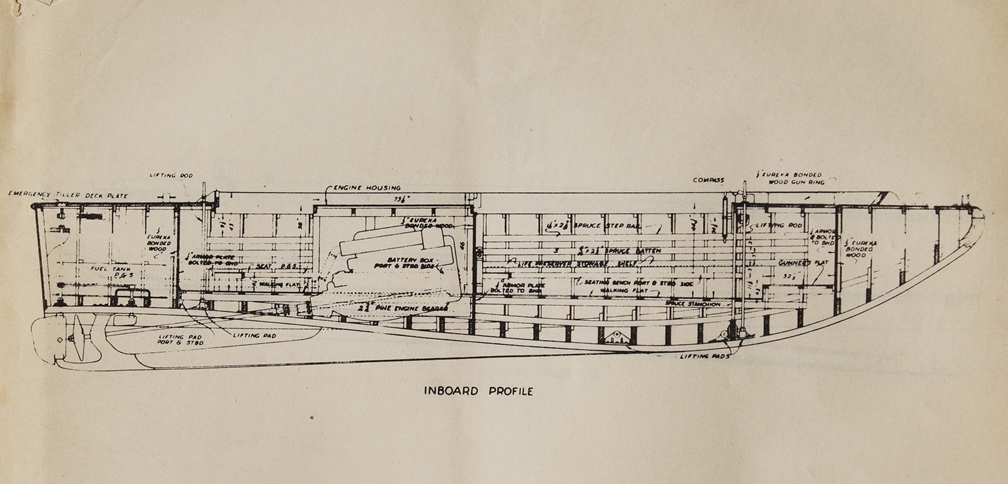
Engineering drawing added 1-30-2020.
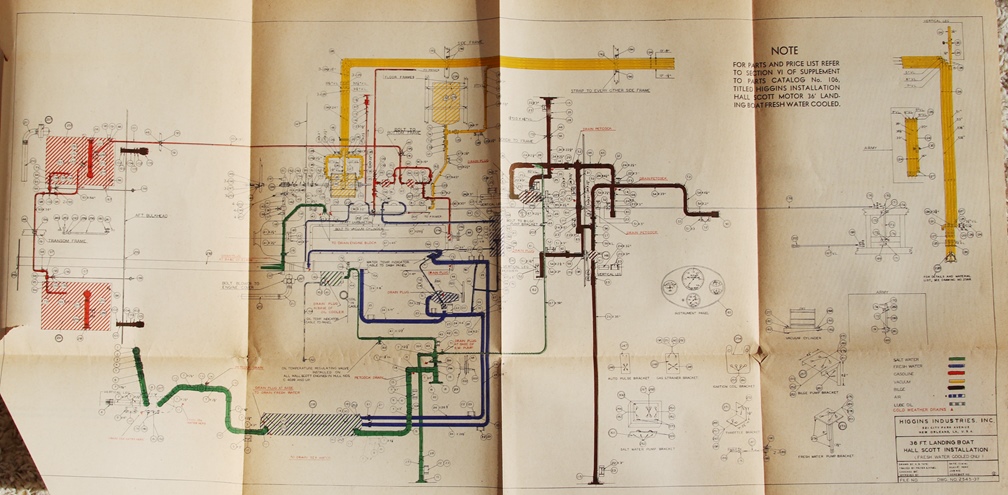
Engineering drawing added 1-30-2020.
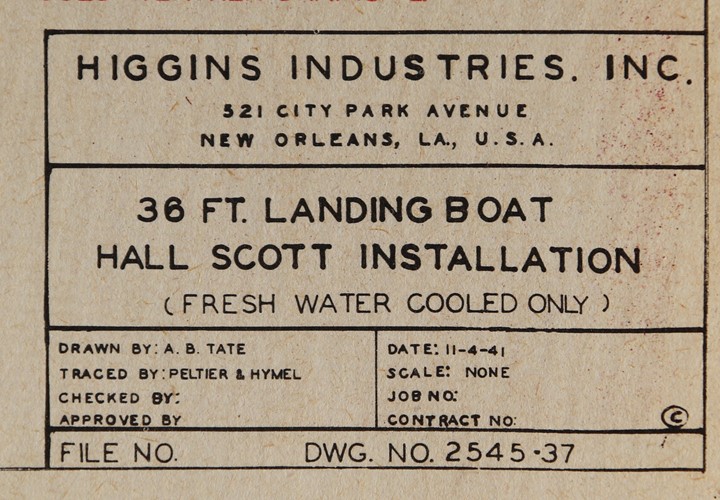
Engineering drawing added 1-30-2020.
LCV (Landing Craft, Vehicle):
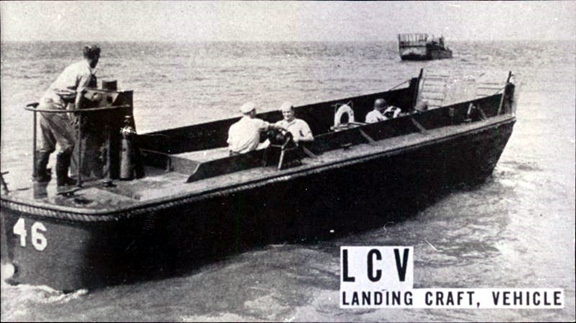
There were 2,633 LCVs built between 1941
and 1943 by Higgins Industries, Chris-Craft, Richardson, and Owens Yacht.
While not built in the
quantities of the LCVP, LCVs saw duty in early American invasions in
World War Two such as Guadalcanal and North Africa. It continued to be utilized even after the LCVP
became the dominant landing craft later in the war.
There are several key differences
between the original LCV and the later LCVP that can be seen in the
photo above and the outline drawing for the LCV shown below.
The most obvious is the coxswain's station, which on the transom of
the LCV. It was moved into the boat on the LCVP. Note
the ramp winch is also located in an exposed position on the port
side of the LCV. In later models of the LVCP it was moved down into the boat
to protect the crewman operating it from hostile fire.
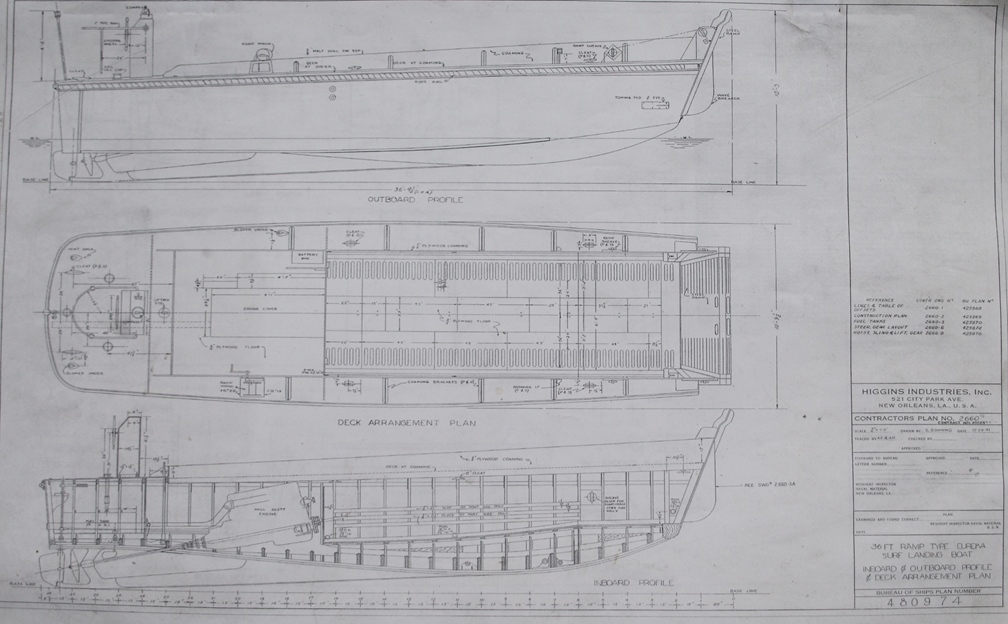
The name given to the LCV at the time of
this drawing on 12-29-1941 was 36 Foot Ramp Type Eureka Surf Landing
Boat. The drawing calls out for a Hall-Scott engine.
Because the date of the drawing is a year before Hudson began production
of the Invader engine the original drawings and engineering layouts were
done with Hall-Scott engines. Engineering drawing courtesy of C. Robert Gillmor added
1-30-2020.
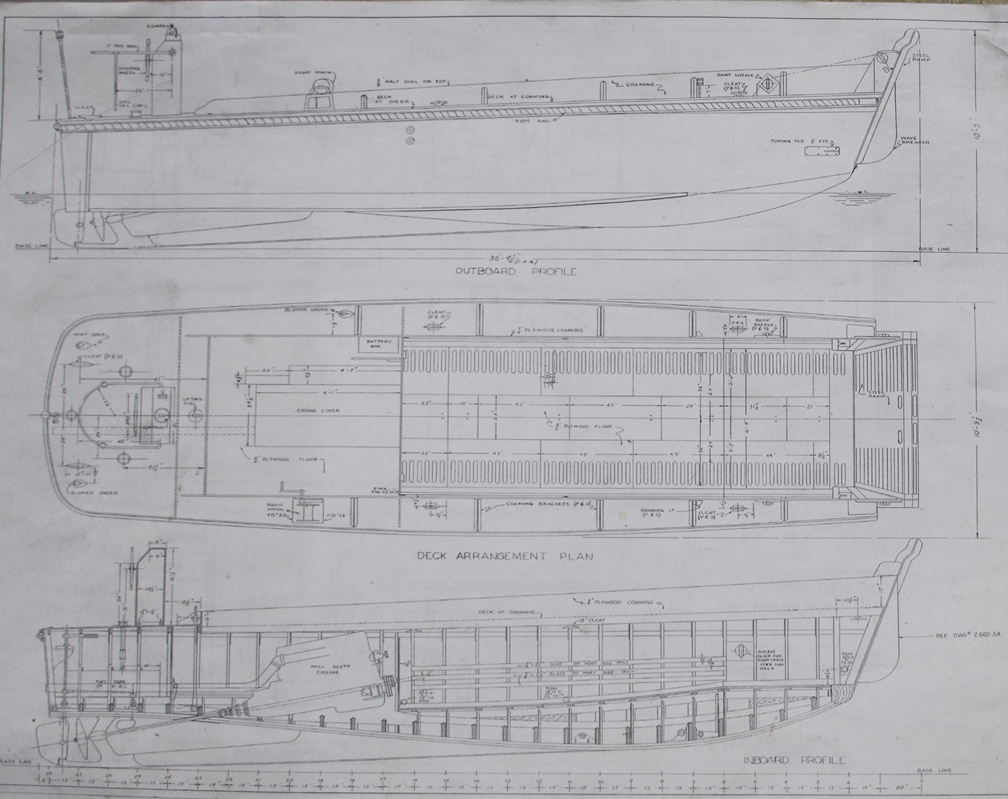
The length of the boat was 36 feet and
4-1/2 inches. It was 10 feet and 9 inches in height, and 10
feet and 9-1/2 inches wide. The engine shown is a Hall-Scott
168 Invader six-cylinder gasoline powered engine. Engineering
drawing courtesy of C. Robert Gillmor added 1-30-2020.
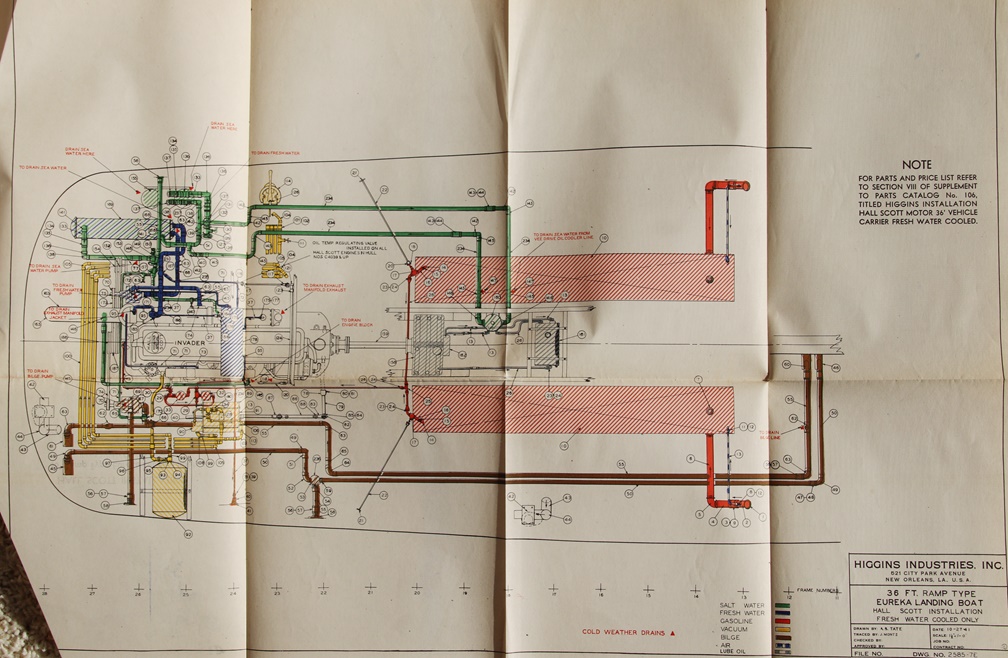
Engineering drawing added 1-30-2020.
LCVP
(Landing Craft Vehicle Personnel):
Both the licensed Hall-Scott Invader engine
and the LCVP started volume production in 1943, so it would appear that
most of the Hudson Invader were used in the LCVP. However, there were 23,358 LCVPs built and only
4,000 Hudson-built Hall-Scott Invader gasoline engines, so they
were in the minority. For combat operations, the US Navy preferred
diesel engines, for which the Gray Marine/Detroit
225hp marine
engine was the engine of choice. LCVPs equipped with the Invader engine were used
extensively in the US
for training purposes.
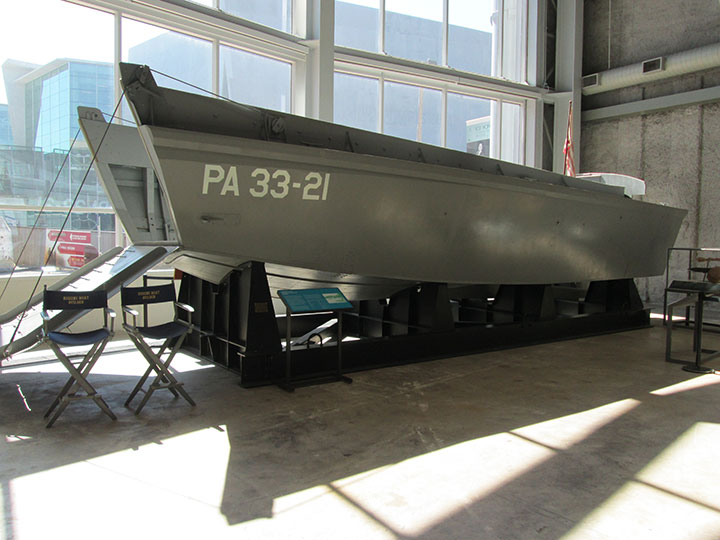
This replica LCVP is located at the National World
War Two Museum in New Orleans, LA. Hudson license built Hall-Scott
gasoline powered marine engines were used when the preferred Gray
Marine/Detroit Diesel engines were not readily available. The Navy
preferred the diesel as it
was used to power its larger ships. Diesel is also not as volatile of a fuel as
the gasoline, making it safer. Landing craft like these with the
Invader engines would have been used in training on the US coasts
allowing the Gray Marine/Detroit Diesel engines to be allocated to the
combat zones. Author's Photo.
LCP(R) (Landing Craft, Personnel, Ramp):
There were 2,631 LCP(R)s built by Chris Craft, Richardson Boat,
and the Matthews Company. Higgins Industries did not build any and
was not responsible for the design of the boat. It was a U.S.
Navy/Chris-Craft design. Higgins considered it to be inferior to
the LCV and LCVP. Production ran from 1942 to 1945 for the LCP(R),
allowing for Hudson Invader engines to be used in this type craft.
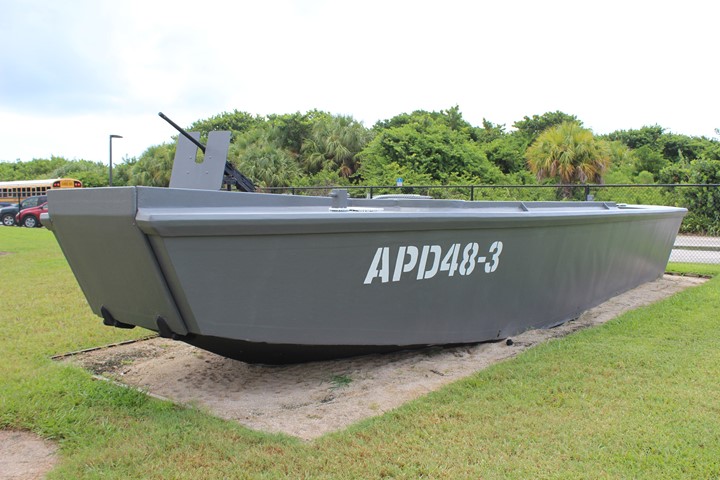
There are no known LCP(R) landing craft
still in existence. This is a replica at the the National UDT-Seal Museum
in Fort Pierce, FL. Author's photo.
Also, my research did not produce evidence the
Invader Engine was used on PT boats as a replacement engine. PT
boats they were all powered by three Packard 4M2500 Marine engines that
produced between 1,200 and 1,500 hp each. One is not going to
replace a bigger engine with one that only gives 1/6th of the
horsepower, as that would be fatal in combat. Also, the Invader
engine would not fit the motor mounts and other connections would not
match. There was no reason to replace a Packard 4M2500 with a
smaller and less powerful engine. This seems to be one of those
old wives' tales that has taken on a life of its own without research or
logic.
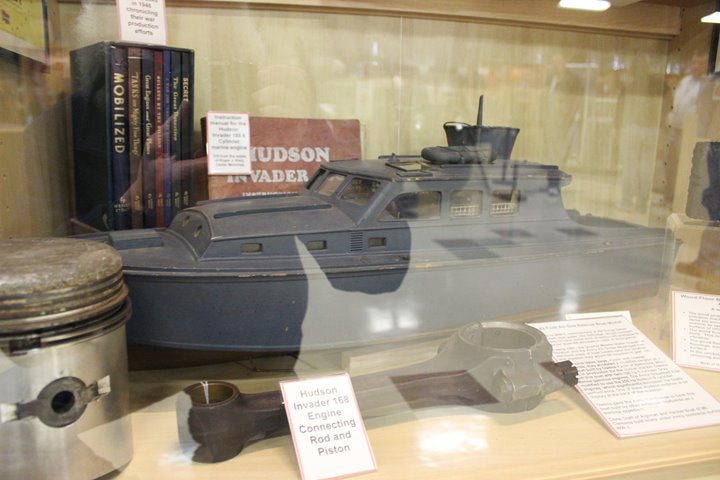
There were several different sizes of Army
Air Forces crash boats during WWII. The smallest, a 42 foot
version like the model shown here, utilized either a Hudson built
Invader engine or a Kermath Sea Ranger 6 Marine engine. The AAF
Handbook for the 42 foot rescue boat calls out for either one. It
is unknown how many Invader engines were used in the 42 foot boats.
This model of a 42 rescue boat is on display at the Michigan Military
Technical and History Society Museum. Author's
photo added 2-21-2017.
Below are drawings of the 42-rescue boat.
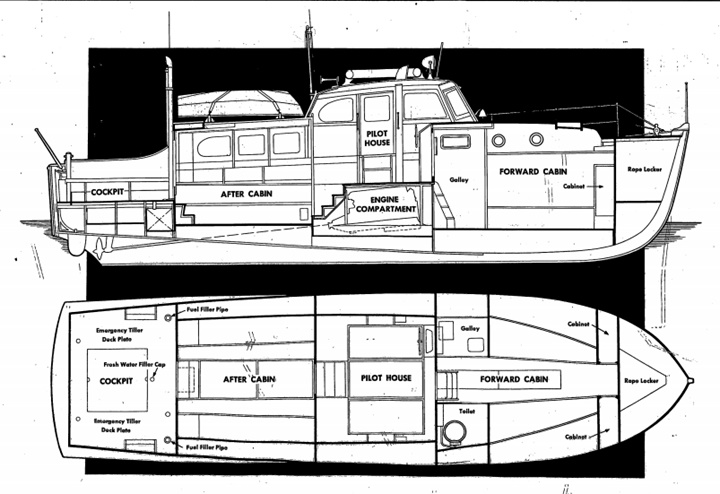
Drawing added 1-30-2020.
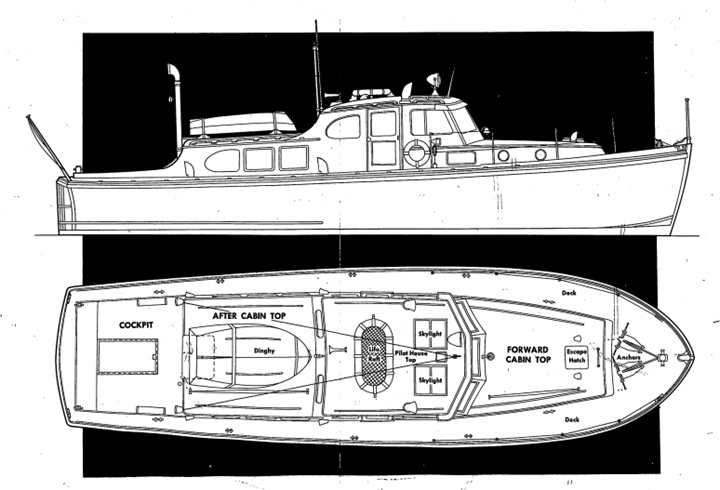
Drawing added 1-30-2020.
The 63 foot crash boat, designated AVR-63
(Auxiliary, or Aircraft, Vessel Rescue), normally had twice the
horsepower of the Invader engine with either two Scott-Hall 650 or
Kermath 550 hp marine engines. Of the 740 built, 20 AVR-63s had
two Hudson Invader 250hp engines, due to shortages of the Hall-Scott
Defender engines. They were vastly underpowered, and were utilized for duty
other than crash rescue.
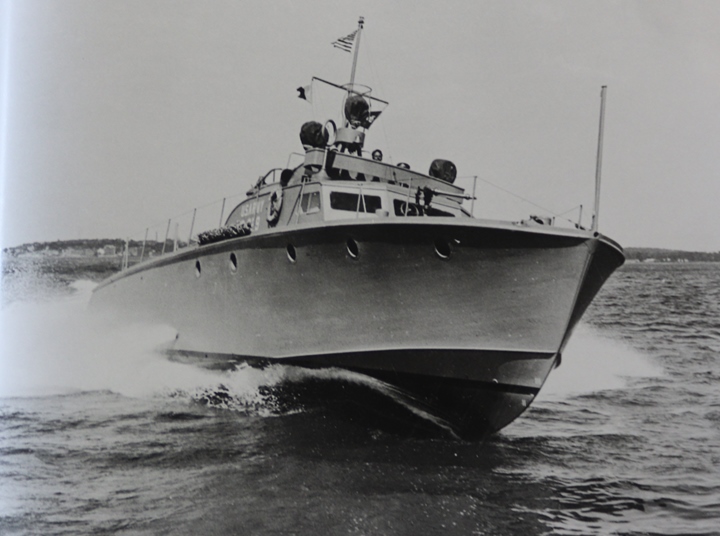
A 63-foot crash boat. Photo added
1-30-2020.
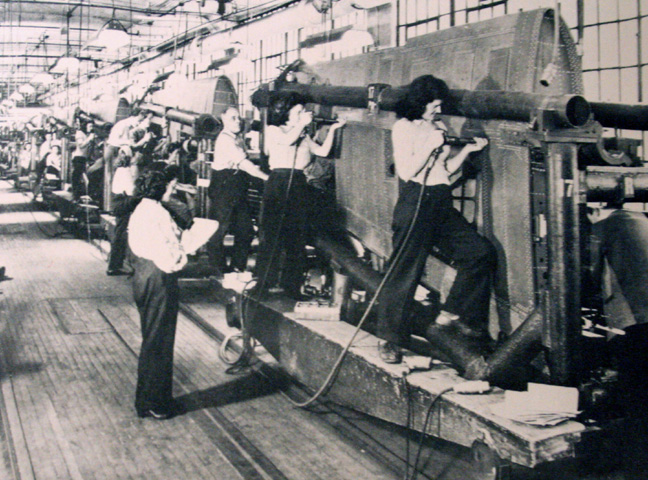
Hudson built 4,250 outer wing sets for the Curtiss SB2C Helldiver, manufactured in Columbus, OH. Production of the
wings ran from January 1943 to August 1945.
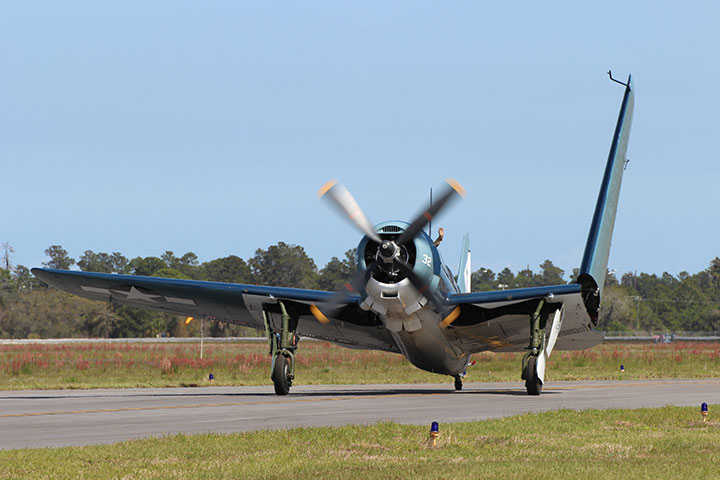
This is the world's only remaining flying
Curtiss SB2C Helldiver, as seen at the 2014 Tico Airshow. Hudson
built 4,250 of the outer wing sections like the ones seen
here. The pilot demonstrates the wing folding ability of the aircraft.
Author's Photo.
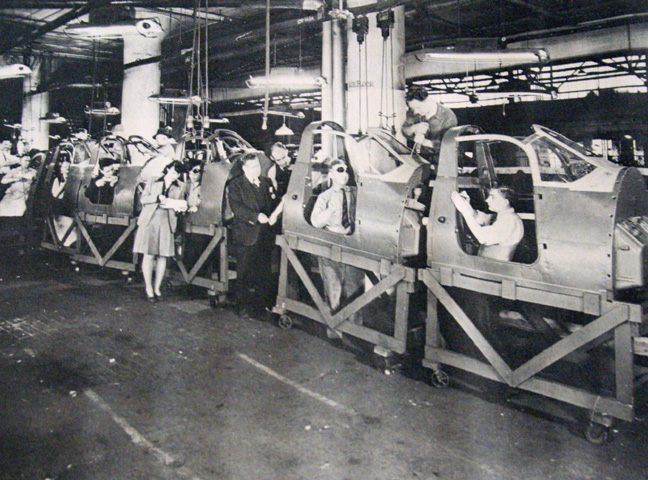
Hudson took on the contract for P-63 cabins
for Bell Aircraft in Niagara Falls, NY in March 1944 running through the end of the war.
The company built a total of 3,041 of the P-63 on an automotive type
production line as seen here.
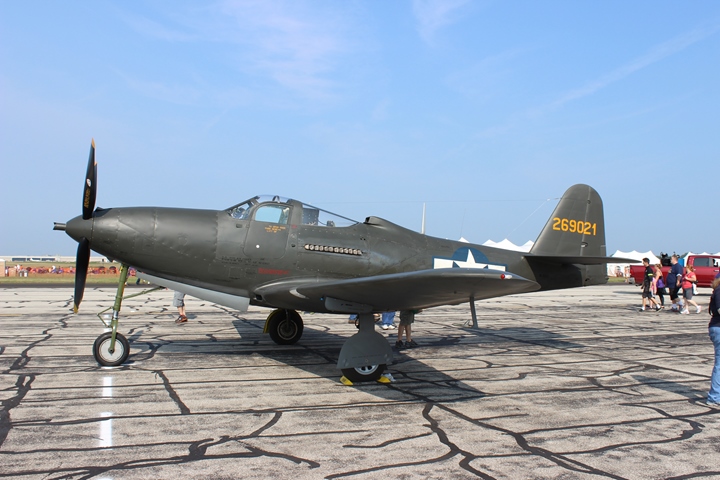
The Bell P-63 King Cobra. The Hudson built cockpit section can be seen after being assembled into
the complete aircraft. The seam between the cockpit section and
the nose section is obvious. Author's
photo added 11-12-2015.
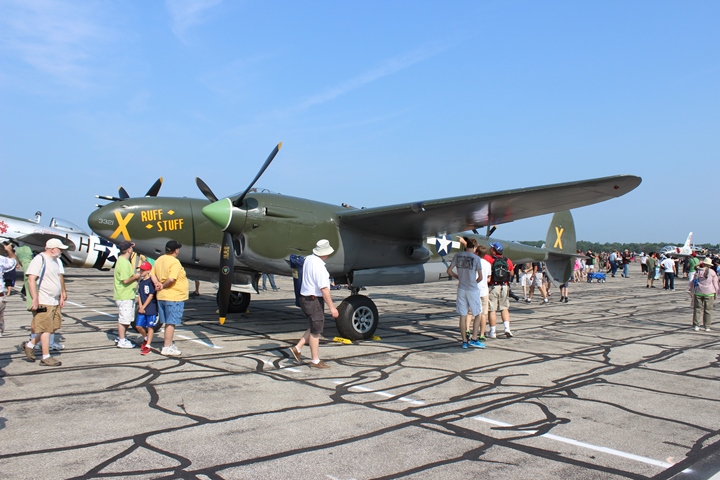
The P-38 is always popular at airshows due
to its unique design. Hudson built 791 wing sets for the Lockheed
Lightning starting in July 1944 and through May 1945. Author's
photo added 11-12-2015.
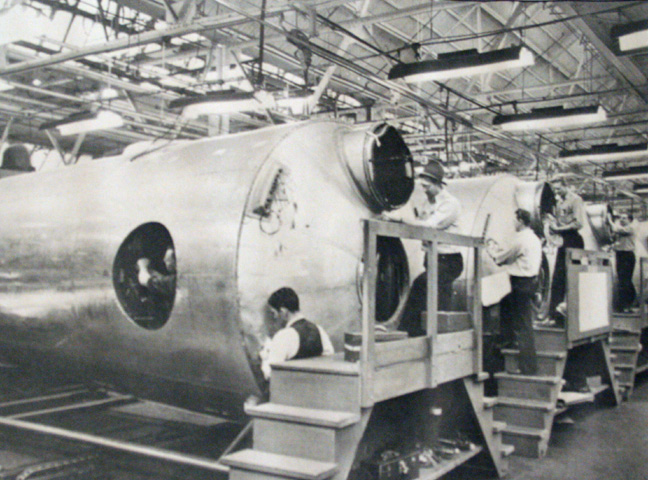
Pictured here are some of the forward B-29
Rear Fuselage Assemblies produced by Hudson. According to the Martin
information presented above, the company also produced two more sections
that were located behind this on the aircraft. Hudson would have
needed to build 531
of each for Martin Omaha production from May 1944 to the end of the war.
This would have been a huge task for Hudson, as the B-29 was a more
complicated and significantly larger aircraft than the previous B-26 for
which Hudson made parts.
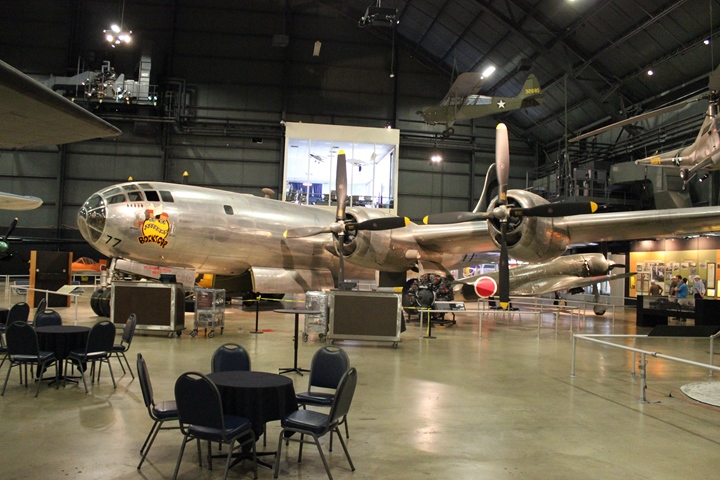
This is Martin Omaha built B-29 "Bockscar",
the second nuclear bomber, as seen on display at the National Museum of
the United States Air Force in Dayton, OH. Just like the "Enola
Gay, it has Hudson built rear fuselage and outer wing sections. Author's
photo added 11-12-2015.
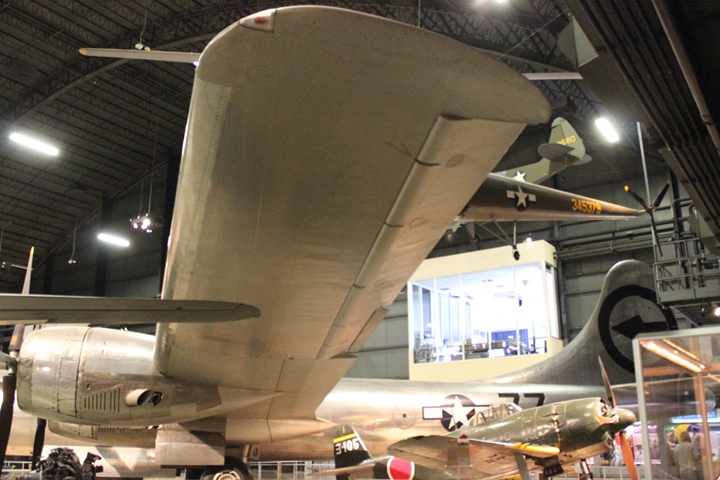
Here the Hudson wing components can all be
seen; the leading edge, wing tip, the wing itself, and the aileron. Author's
photo added 11-12-2015.
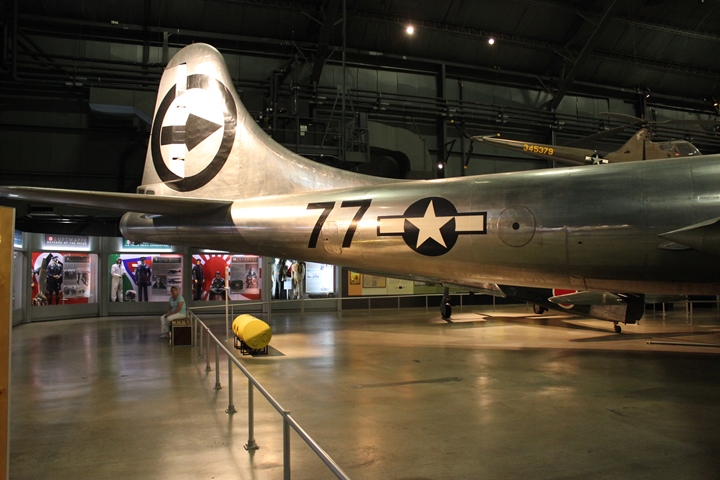
The three Hudson built rear
fuselage sections can be seen. Author's photo added 11-12-2015.
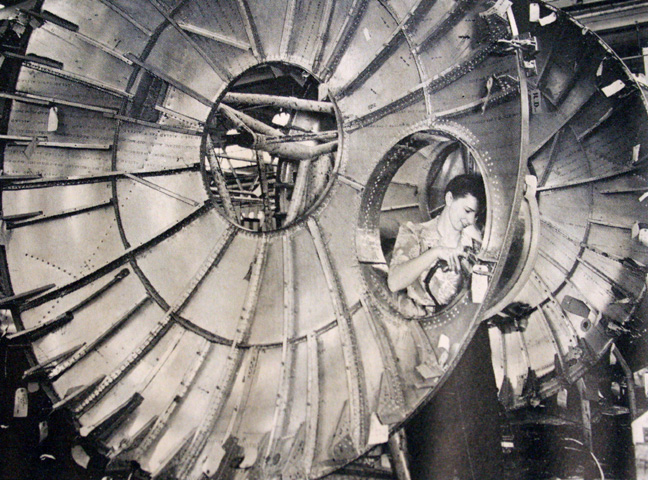
B-29 Bulkheads for the pressurized cabins in
the aircraft are being worked on.
The table below details the production
schedule that Hudson, and other suppliers, had to meet to supply components for the Martin Omaha, NB built B-29s.
Several months show no production, or at least no accepted
production. It could have been that there was a parts shortage
that did not allow the aircraft to be finished and accepted by the US
Army Air Force. I do think the work stoppages were intentional.
Aircraft in WWII were built in Block Numbers,
which had frozen designs and did not allow for any changes to the
aircraft while coming down the production line. This allowed mass
production of aircraft without having to make the constant changes and
improvements based on information coming back
from testing and operational units. When a new block was started,
it contained updates and improvements. Even then to
facilitate production, not all of the upgrades would be included.
Afterward, the aircraft would go to one of nineteen modifications
centers for the latest updates. The modification centers were
integral to the process of keeping the aircraft production
lines operating efficiently. In the case of Martin Omaha, it
had its own modification center.
Serial numbers reflect the year the aircraft
were ordered, as indicated by the first two numbers in the sequence.
The first B-29 built at Martin Omaha was the 65202nd aircraft ordered by
the US Army Air Force in 1942. The last one off the assembly line
in August 1944 was the 86273rd aircraft ordered in 1944.
MO designated that the aircraft was built at
Martin Omaha.
Of the four plants making B-29s during WWII,
Martin in Omaha, NB was chosen to build and then modify the operational
B-29s for the nuclear bomber "Silverplate" program. Martin was considered by the US Army Air Force to have the best
quality of the four plants. The first fifteen came directly off
the assembly line went to Wendover Army Air Field, Utah. Once
there, they were converted to the "Silverplate" configuration and then
used in training.
The fifteen operation "Silverplates" that went
to Tinian were also built at Martin and modified at the adjacent
modification center. Modifications included, but were not limited
to, replacing the Hamilton Standard propellers with Curtiss Wright
Electric reversible props, the elimination of all of the gun turrets,
gun sights, and gun control computers with the exception of the tail
turret, and modification of the bomb bays to accept the large atomic
devices.
|
Martin Omaha,
Nebraska World War Two B-29 Production Schedule |
|
Month |
Number built |
Block Number |
First Serial Number |
Last Serial Number |
Comments |
| 1944 |
|
|
|
|
|
| May
|
3 |
B-29-MO-1 |
42-65202 |
42-65204 |
|
| June |
7 |
B-29-MO-5 |
42-65205 |
42-65211 |
|
| July
|
0 |
|
|
|
|
|
August |
8 |
B-29-MO-10 |
42-65212 |
42-65219 |
|
|
September |
16 |
B-29-MO-15 |
42-65220 |
42-65235 |
|
|
October |
28 |
B-29-MO-20 |
42-65236 |
42-65263 |
|
|
November |
0 |
|
|
|
|
|
December |
50 |
B-29-MO-25 |
42-65264 |
42-65313 |
|
|
1944 Total |
112 |
|
|
|
|
| 1945 |
|
|
|
|
|
|
January |
69 |
B-29-MO-30 |
42-65315 |
42-65383 |
|
|
February |
18 |
B-29-MO-35 |
42-65384 |
42-65401 |
|
|
February |
67 |
B-29-MO-35 |
44-27259 |
44-27325 |
The B-29 "Bockscar"
was serial number 44-27297 and came off the Martin Omaha
assembly line in February 1944. |
| March |
0 |
|
|
|
|
| April |
0 |
|
|
|
|
| May
|
33 |
B-29-MO-40 |
44-27326 |
4-27358 |
|
| May
|
35 |
B-29-MO-40 |
44-86442 |
44-86276 |
|
| May
|
39 |
B-29-MO-45 |
44-86277 |
44-86315 |
The B-29 "Enola Gay"
was serial number 44-86292 and came off the Martin Omaha
assembly line in May 1944. |
| June |
55 |
B-29-MO-50 |
44-86316 |
44-86370 |
|
| July
|
55 |
B-29-MO-55 |
44-86371 |
44-86425 |
|
|
August |
48 |
B-29-MO- 60 |
44-86426 |
44-86473 |
|
|
1945 Total |
419 |
|
|
|
|
|
Grand Total |
531 |
|
|
|
|
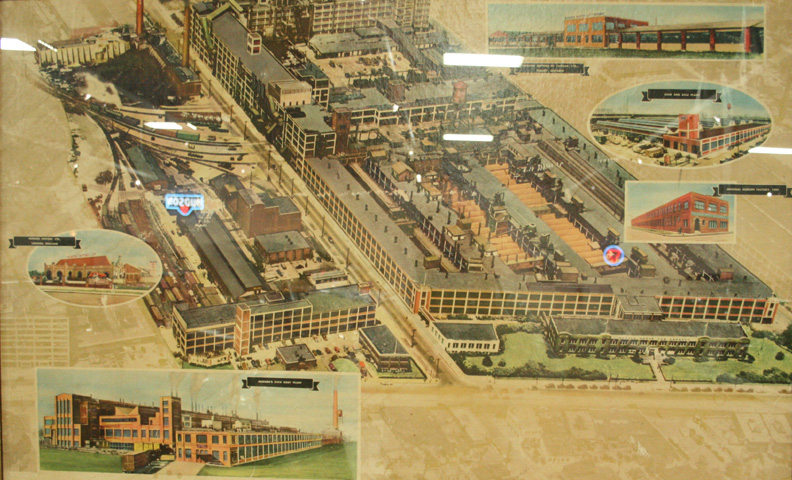
The Hudson Plant on East Jefferson in Detroit,
MI. This is probably pre WWII drawing of the plant. Compare
to the 1947 version below.
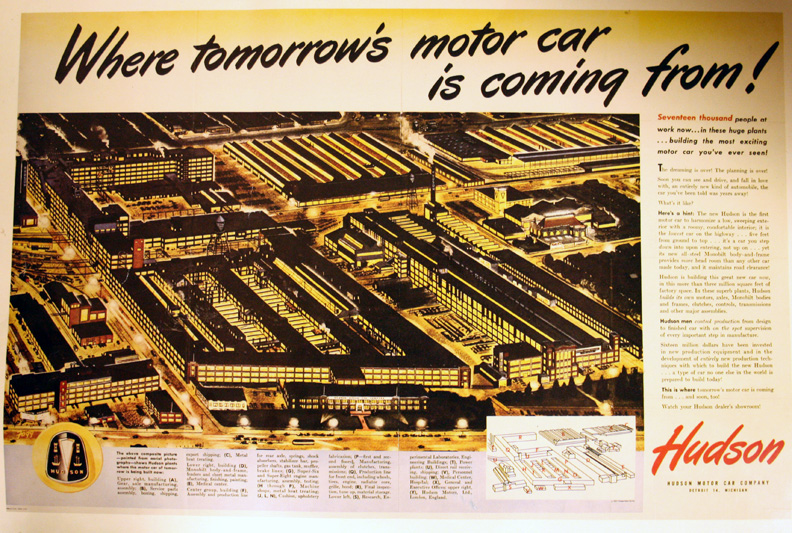
This is the plant in 1947. Note the
expansion that has taken place to the Northeast of the original plant.
After the consolidation of Hudson with Nash-Kelvinator to form American
Motors, production moved to Kenosha, WI. The above plant was torn down
in 1961. Apparently a portion of the facility was spared and a
warehouse for the plant is still in use. From below, it would appear
that 17,000 jobs disappeared in Detroit with the 1954 merger.

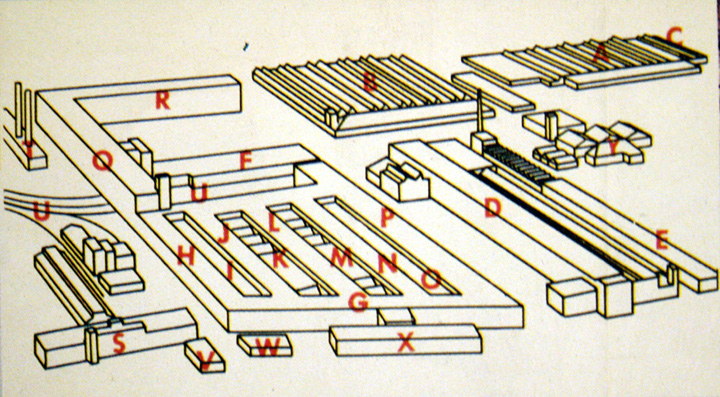

|
























































